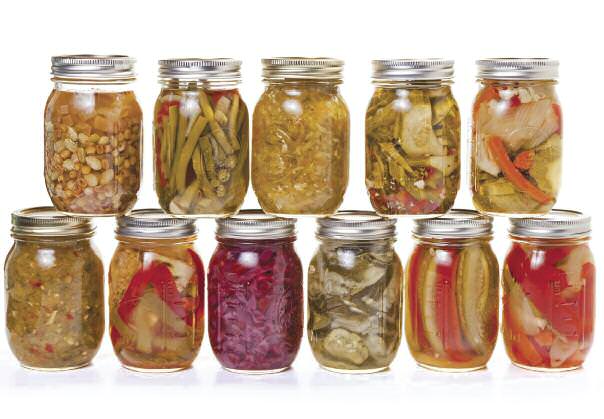edible endeavors
HOME CANNING BASICS
Tips for preserving your harvest, whether tart or sweet.
WRITTEN BY KAY FAHEY
PHOTOS BY CHRIS HOLLOMAN
Preserving the harvest is a time-honored tradition, and canning is one of the most popular ways to preserve. There are all sorts of reasons for you to can summer’s last fruits and vegetables: to ensure the quality of your food, teach traditions to the next generation, or maybe even establish a business. But one of the best reasons is that canning opens new possibilities for culinary creativity.
“Any new flavor you want to create is always worth a try,” says Donna Amato of Amato’s Family Kitchen, a local purveyor of award-winning preserves and candies.
Give your creations your own stamp by adding your favorite aromatics — herbs and spices, wines and liqueurs — and using unique combinations of fruit. Once you have your preserves, the only limit to how you use them is your imagination. Try glazing roast chicken with tart crabapple jelly, or thinly spreading fig jam on ham sandwiches. Or, add a dollop of your favorite preserve to vinaigrettes and gravies.
The most recommended canning method is water-bath canning, used for the things people most commonly want to can: jams and jellies, pickles, and fruit butters.
Water-bath canning involves putting prepared food into pristine jars, then immersing the sealed jars in boiling water until bacteria have been eliminated. Guidelines giving the details of water-bath canning are available online and in most canning books. Christina Turner of the University of Nevada Cooperative Extension recommends the Colorado State University Extension’s Guidelines, which are designed for high-altitude preserving.
Turn your creativity loose in preparing the food to go into the jars, choosing just the right ingredients, crafting your own specialties, and sampling the delectable results along the way. Marcia Litsinger, who operates Churchill Butte Organics farm in Stagecoach, Nev., and teaches canning locally, combines two types of orange, Meyer lemons, and Mandarin oranges in her citrus marmalade.
Lee Zuti, treasurer of the Silver Stage Co-op in Silver Springs, Nev., also gets creative with ingredients, asserting you can make pickles out of anything. And while she reassures beginners that canning is not rocket science, Zuti recommends taking a class.
“Canning is more fun when you work and learn with someone else,” she says.
Donna Amato, who won several prizes at the last Nevada State Fair (including Best of Show for her strawberry jam), has turned her enthusiasm for sharing preserves into a thriving business.
“Always share,” she says, “whether with family and friends or a food bank. It comes back to you in all sorts of unexpected ways.”
Food writer Kay Fahey cans crabapple jelly, blackberry jam, and tomato sauce from farmers’ market produce and her own garden — just like her mom taught her.
The Problem with Pectin
Fruit jells as a result of pectin, which naturally is present in all fruit. But the amount of natural pectin varies according to several factors, and often there isn’t enough to achieve the luscious texture you want. This is why most recipes specify adding commercial pectin to guarantee the right results.
The problem is most commercial pectins require lots of sugar to work. There are a few exceptions, including a brand recommended by Marcia Litsinger: Pomona’s Universal Pectin. Available at the Great Basin Community Food Co-op and Williams-Sonoma in Reno, it’s derived from citrus. What makes it so different is that it works with non-sugar sweeteners such as stevia, making it a real find for those who want to minimize their sugar intake.
Reading List
Williams-Sonoma canning guides
www.Williams-sonoma.com
Ball Complete Book of Home Preserving (Try Sundance Books and Music in Reno)
Home Canning from Sunset Books (Try Sundance Books and Music in Reno)
Colorado State University Extension guides
Www.ext.colostate.edu/pubs/foodnut/09348.html
Where to Find Canning Supplies
Carter Brothers Ace Hardware
1215 S. Virginia St., Reno
775-337-1200
Williams-Sonoma
13945 S. Virginia St. (at The Summit mall), Reno
775-853-6877, www.Williams-sonoma.com
Expert Advice
• Do your homework and plan ahead.
• Assemble everything you will need before beginning.
• The best produce gives the best results.
• Avoid vegetables unless pickling them.
• Work in small batches.
• Adjust recipes for altitude.
• Cleanliness cuts risk.
• Store finished jars in a cool, dry place where you can admire them.
• Go for it!
Profitable Preserving
Nevada’s new Cottage Food Industries law (SB-206, effective July 1, 2013) legalized the direct sale of certain foods, including jams and jellies, to the public. This means that if you, like Amato, create some spectacular preserves, you can sell up to $35,000 worth of the goods each year at face-to-face venues such as farmers’ markets. You no longer need to work from a commercial kitchen in order to sell your masterpieces to the public. For details, visit Cottagefoods.org/laws/usa/nevada/. California passed a similar law on Jan. 1, 2013 (California Homemade Food Act, AB-1616). For details, visit Theselc.org/cottage-food-laws.


